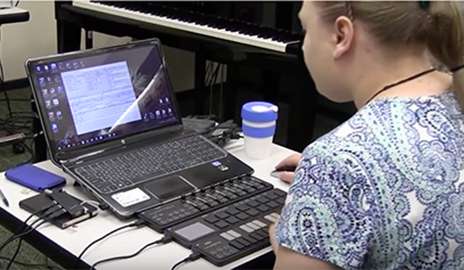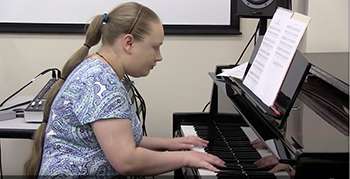You'd never know it wasn't Bach (or even human)

In her spare time, when she can find any, Donya Quick composes music, typically jazz, generally on the six-foot baby grand piano that dominates her apartment's living room. A baby grand isn't an all-hours option in a multi-unit building, so she also keeps a Yamaha silent guitar on hand, for the days when inspiration strikes late in the evening.
"I like to compose at 11 p.m.," says Quick, a lecturer in computer science at Yale. "I have been able to use that piano so little, the keys are starting to get sticky."
For most of the last two years, Quick, who is originally from Virginia, largely subordinated her compositional impulse to the demands of another type of musical project: The fine tuning of a computer program she developed to create music for her—original, never-before-heard music that sophisticated listeners have mistaken for the fruit of a sublime human sensibility.
In two separate tests, each involving more than 100 human subjects of varied musical experience, participants listened to 40 short musical phrases, some written by humans, others by computer programs, including Quick's, which she calls Kulitta. The subjects were asked to rate the musical phrases on a seven-point scale ranging from "absolutely human" to "absolutely computer." In both tests, Kulitta's compositions rated, on average, on the human side of the scale.
The late Paul Hudak, Quick's dissertation adviser at Yale, organized a separate series of informal public demonstrations where he juxtaposed a musical phrase composed by Kulitta with a phrase by J.S. Bach, the 17th-century German musical genius famous for his cello suites, fugues and chorales. Hudak then challenged audience members to identify which was which; invariably, even some music sophisticates confused Kulitta's phrase for work by Bach.
"It really does work, and that judgment isn't just based on a few people listening to a few of the pieces that have been produced," says Holly Rushmeier, a Yale computer science professor who has seen the system in action. "I was impressed with the user study that verified how effective the system is. Kulitta produces wonderfully sophisticated compositions."
Unnerving automation
Automation unnerves some people, and the automation of art has a special power to offend humanity's view of itself as soulful: How could a thing without psychological or emotional states express itself with the spirit and feeling seemingly necessary for making music? "Before I encountered any of this stuff, I probably would have had a similar reaction," Quick says. "It's an adverse reaction to novelty, the same way people first reacted to synthesizers."
Konrad Kaczmarek, a composer and assistant professor in the Department of Music, says Kulitta and other new technologies are likely to change the way composers write, perform, and listen to music. But the fundamental elements of composition will remain the same, he explains.
"Whether it's someone with a computer or a guy strumming a guitar, it's always an algorithmic process," Kaczmarek says. "You begin with an unlimited palette, and then apply different rules and decision-making strategies to filter it all down. Adding a computer to the equation, with an analysis of every Bach chorale ever written as a data set, influences the entire process in exciting and powerful ways."
Quick does not want to put human composers out of business. Indeed, she thinks computer music generators can serve as a fresh source of ideas for musicians and as a tool for studying how humans actually experience music. She also thinks programs like Kulitta could allow people without advanced musical skills to engage in composition at a fairly high level—"sort of like being the director of a movie rather than the scriptwriter," she says.
Viewed this way, programs like Kulitta are a help to human musicians, not a threat. "They're another tool in the toolbox," Quick says. "People can use this to do what they already were doing, but better."
By several accounts, Kulitta is one of the most versatile automated musical composition programs developed to date, surpassing well-known predecessors in its ability to blend dissimilar musical styles to pleasing effect. Even David Cope, the celebrated composer and computer music innovator, was impressed by the demonstration Quick gave him during a visit to Yale. "He was very positive when he heard the Kulitta woodwind piece," she said.
To be sure, Quick is not the first to create computer programs to write music. Cope, one of Quick's role models, did it decades ago. His programs "Emily Howell" and "Emmy" have written thousands of classical compositions, from sonatas and concertos to chamber orchestra opuses and pieces for multiple pianos. The programs also helped him complete an opera he began but couldn't seem to finish. Cope remains a towering figure in the field of computer music. But as Hudak, the Yale computer scientist, saw it, Quick has gone a step further than Cope: With Kulitta, Hudak once said, "You can create sounds that no one's ever heard before."
"Top down" approach
It was Hudak, in fact, who suggested that Quick call her program "Kulitta" after a female musician from Hittite mythology. Like existing automated composition systems, Kulitta has the ability tolearn musical properties, such as abstract rules for harmony and pitch mapping, from a corpus of existing compositions (in this case, Bach chorales primarily). Kulitta also has the ability to write music with a "top-down" approach that composes by eliminating musical elements it does not want to use.
But Kulitta differs from other composition systems in important ways. Above all, there is its versatility. Where Cope's justly celebrated programs can produce realistic, enjoyable music that largely works within established styles (using information about chorales to produce more chorales), Kulitta can use the structures of different musical forms and combine them to create music that sounds distinctly like something else altogether.
Firing up a laptop computer in the Euterpea Studio at Yale's Watson Hall, surrounded by silent guitars, synthesizers, and drum kits, Quick demonstrates the process. She asks Kulitta to compose a 30-second piece in the style of a Bach chorale, but with a middle block that incorporates a jazz harmony. The jazzy block is then run back through the chorale parameters. The result takes less than 10 seconds.
"That wasn't bad," Quick says, after human ears have heard the piece for the first time. "I'm going to save that one. You can think of it as, 'This might be what Bach would have done if he knew about jazz.'"
Beyond bioinformatics
Quick came to Yale from Southern Methodist University, where she received bachelor's and master's degrees in computer science (and a second bachelor's degree in environmental studies). In 2008, as she anticipated her doctoral studies in New Haven, she planned to continue with the bioinformatics research she'd begun in Texas, which involved analyzing the DNA of nematode worms.
She was interested in computers as a source of music, but had little exposure to it. "I was completely unaware of the potential that existed for automated composition, since the only algorithmic compositions I'd come across were really quite awful sounding," she says.
In August 2008, she and her husband, a graduate student in psychology at the University of Connecticut, drove from Texas to Connecticut with their load of musical instruments, including three guitars, a keyboard, a theremin, and some other stringed instruments, including an oud and bouzouki. Soon after arriving she saw that Hudak was offering a course in computer music, "Fundamentals of Computer Music: Algorithmic and Heuristic Composition."
"As soon as I heard about it, I decided I had to take it and planned my schedule around it, although I really had no idea what to expect beyond the idea that it somehow involved two things I liked a lot: programming and music," Quick says. "The subject was intriguing to me, but also completely mysterious at the time. I haven't looked back."
Indeed not. She envisioned, developed, and began refining Kulitta, which became the subject of her dissertation in 2014. At the heart of Kulitta is a four-module process that transforms human directives into musical dialogue.

The first module establishes musical properties. In computer programming terms, it would look something like this: p=learn(corpus). The second module produces an abstract musical structure: a=generate(p); the third module creates musical chords: c=harmony(a,h); and the fourth module puts everything into a specific musical framework: music=style(c,chorale).
"Kulitta can produce a piece of music incredibly fast," Quick says. "For something that would take at least a day for a human, Kulitta can do it in a few seconds or less."
Metallica and Mozart
Quick's ambitions for Kulitta will take a bit more time. Now that she's produced mergers of classical and jazz, she'd like to do something even bolder. "The one I want to try is Metallica and Mozart," she says. "I'd like Kulitta to do a rock symphony, at some point. That's my pie-in-the-sky."
In May, as a tribute to her late mentor, Quick played a Kulitta composition at a memorial service for Hudak. "I found it quite moving," said Dana Angluin, a Yale computer science professor who attended the service, and who has worked with Quick.
Quick also has allowed a number of Yale students to work with Kulitta for term projects in a class she taught.
Such uses speak to one of the main ways Kulitta can be of service, according to Quick. Kulitta can quickly test a compositional idea for a classical concerto or a jazz harmony and spark an intellectual or emotional response. Not only can Kulitta accomplish this sort of test quickly, it can produce many variations on the same, specific musical idea and tailor them to the physical dimensions of the musician's hands.
As to what Kulitta cannot do, says Quick, it cannot beat Bach at his own musical game. To say Kulitta composes music that has been confused for works generated by the mind of Bach is not to say the computer is as good a composer as Bach, she notes. "It's kind of hard to match the gold standard. Bach defined a style, with specific rules. Kulitta will have mistakes, by that definition."
Kulitta also will evolve. Quick says that if people like what they hear from Kulitta now, they'll like version 2.0 better. She continues to expand Kulitta's musical vocabulary and refine its understanding of compositional nuances. She is planning another listening test and has had an academic paper accepted for an international computer music conference.
Someday, Kulitta may even sing.
"This is a life's work," Quick says. "I would like to keep building a bigger, better, more proficient Kulitta."
Provided by Yale University


















